Qing-dai powder promotes recovery of colitis by inhibiting inflammatory responses of colonic macrophages in dextran sulfate sodium-treated mice
- PMID: 26464580
- PMCID: PMC4604072
- DOI: 10.1186/s13020-015-0061-x
Qing-dai powder promotes recovery of colitis by inhibiting inflammatory responses of colonic macrophages in dextran sulfate sodium-treated mice
Abstract
Background: Qing-dai powder (QDP), comprising Indigo naturalis (Qing-dai) and dried alum (Ku-fan), was used in Chinese medicine to treat the conditions associated with mucosal hemorrhage, such as ulcerative colitis (UC). This study aims to investigate the effects and potential mechanism of QDP on dextran sulfate sodium (DSS)-induced acute colitis in mice and to examine the regulatory effects of QDP on macrophages.
Methods: Seven- to eight-week-old male C57BL/6 mice were challenged with 2.0 % DSS in drinking water for 5 days and then the colitic mice were arbitrarily allocated into five groups (n = 10 for each group). QDP (0.77, 1.54 and 3.08 g/kg) and sulfasalazine (SASP) (0.20 g/kg) were orally administered for 7 days. The disease activity index was determined by scores of body weight loss, diarrhea and rectal bleeding; histological signs of damage was analyzed by H&E staining; myeloperoxidase activity was measured by colorimetric method, levels of proinflammatory cytokines were determined by ELISA; changes in macrophages in the colon were analyzed by immunohistochemistry (IHC) and flow cytometry. Lipopolysaccharide (LPS)-induced RAW264.7 cells were treated with or without QDP, then the production of TNF-α and IL-6 were measured by ELISA; and protein molecules such as COX-2, iNOS, IкB-α were determined by Western blot.
Results: Oral administration of QDP at dosages of 1.54 and 3.08 g/kg significantly reduced disease activity index on day 12 (P < 0.001 for 1.54 g/kg and P < 0.0008 for 3.08 g/kg), colon shortening (P = 0.012 for 1.54 g/kg, P = 0.001 for 3.08 g/kg), histological damage (P < 0.001 for 1.54 g/kg, P < 0.001 for 3.08 g/kg) and colonic myeloperoxidase activity (P = 0.002 for 1.54 g/kg, P < 0.001 for 3.08 g/kg) of DSS-treated mice. Moreover, QDP treatment (1.54 and 3.08 g/kg) significantly decreased DSS-induced infiltration of macrophages, and production of TNF-α (P = 0.005 for 1.54 g/kg, P = 0.002 for 3.08 g/kg), IL-1β (P = 0.008 for 1.54 g/kg, P = 0.002 for 3.08 g/kg) and IL-6 (P = 0.011 for 1.54 g/kg, P = 0.004 for 3.08 g/kg) in colonic tissues, and also reduced serum MCP-1 levels (P = 0.001 for 1.54 g/kg, P < 0.001 for 3.08 g/kg). In RAW264.7 cells, QDP significantly suppressed LPS-induced production of TNF-α and IL-6 (Both P < 0.001 for 1.0 μg/mL QDP treatment) and expression levels of COX-2 (P = 0.002 and P = 0.001 for 1 and 3 μg/mL QDP treatment, respectively) and iNOS (P < 0.001 for 3 μg/mL QDP treatment) by inhibiting IкB-α degradation (P = 0.007 and P = 0.004 for 1 and 3 μg/mL QDP treatment, respectively) and NF-кB p65 nuclear translocation.
Conclusion: QDP suppressed the inflammatory responses of colonic macrophages in DSS-induced UC in mice and LPS-induced RAW264.7 cells.
Figures







Similar articles
-
Anti-inflammatory properties of uvaol on DSS-induced colitis and LPS-stimulated macrophages.Chin Med. 2020 May 7;15:43. doi: 10.1186/s13020-020-00322-0. eCollection 2020. Chin Med. 2020. PMID: 32411289 Free PMC article.
-
Anti-inflammatory effects of Brucea javanica oil emulsion by suppressing NF-κB activation on dextran sulfate sodium-induced ulcerative colitis in mice.J Ethnopharmacol. 2017 Feb 23;198:389-398. doi: 10.1016/j.jep.2017.01.042. Epub 2017 Jan 22. J Ethnopharmacol. 2017. PMID: 28119098
-
Jianpi Qingchang decoction alleviates ulcerative colitis by inhibiting nuclear factor-κB activation.World J Gastroenterol. 2017 Feb 21;23(7):1180-1188. doi: 10.3748/wjg.v23.i7.1180. World J Gastroenterol. 2017. PMID: 28275298 Free PMC article.
-
Artemisinin analogue SM934 ameliorates DSS-induced mouse ulcerative colitis via suppressing neutrophils and macrophages.Acta Pharmacol Sin. 2018 Oct;39(10):1633-1644. doi: 10.1038/aps.2017.185. Epub 2018 May 31. Acta Pharmacol Sin. 2018. PMID: 29849131 Free PMC article.
-
Safranal Alleviates Dextran Sulfate Sodium-Induced Colitis and Suppresses Macrophage-Mediated Inflammation.Front Pharmacol. 2019 Nov 1;10:1281. doi: 10.3389/fphar.2019.01281. eCollection 2019. Front Pharmacol. 2019. PMID: 31736758 Free PMC article.
Cited by
-
Effects of molecular weight on intestinal anti-inflammatory activities of β-D-glucan from Ganoderma lucidum.Front Nutr. 2022 Sep 29;9:1028727. doi: 10.3389/fnut.2022.1028727. eCollection 2022. Front Nutr. 2022. PMID: 36245525 Free PMC article.
-
Colitis with wall thickening and edematous changes during oral administration of the powdered form of Qing-dai in patients with ulcerative colitis: a report of two cases.Clin J Gastroenterol. 2018 Aug;11(4):268-272. doi: 10.1007/s12328-018-0851-7. Epub 2018 Mar 16. Clin J Gastroenterol. 2018. PMID: 29549501
-
Indigo Naturalis Ameliorates Dextran Sulfate Sodium-Induced Colitis in Mice by Modulating the Intestinal Microbiota Community.Molecules. 2019 Nov 12;24(22):4086. doi: 10.3390/molecules24224086. Molecules. 2019. PMID: 31726738 Free PMC article.
-
Rapid and Integrated Quality Assessment of Organic-Inorganic Composite Herbs by FTIR Spectroscopy-Global Chemical Fingerprints Identification and Multiple Marker Components Quantification of Indigo Naturalis (Qing Dai).Molecules. 2018 Oct 24;23(11):2743. doi: 10.3390/molecules23112743. Molecules. 2018. PMID: 30352981 Free PMC article.
-
Anti-inflammatory properties of uvaol on DSS-induced colitis and LPS-stimulated macrophages.Chin Med. 2020 May 7;15:43. doi: 10.1186/s13020-020-00322-0. eCollection 2020. Chin Med. 2020. PMID: 32411289 Free PMC article.
References
LinkOut - more resources
Full Text Sources
Other Literature Sources
Research Materials
Miscellaneous

